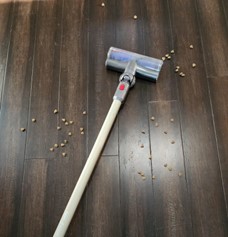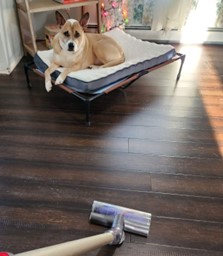Many dogs leave the room as soon as the “vacuum villain” shows up. They may tremble in fear, slink off to the couch to hide, or even bite or bark at the vacuum to make it go away.
Why do dogs fear the vacuum?
- Fear of the unknown: “What IS that scary monster?”
- Sensitivity to noise: “Ouch, that hurts my ears!”
- A past traumatic event: “That monster tried to bite me once!”
- Unpredictability: “That monster moves all over the place, and I can’t escape!”
It is possible to help your dog work through their big feelings about the vacuum by first recognizing how they really feel and then using behavior modification to change those feelings from bad to good or neutral.
How to Help:
Step 1: Provide a safe haven. This is somewhere your dog can go, be comfortable, hide, and not worry about the vacuum. Be sure your dog is already used to this safe space and associates it with good things. Before you vacuum, encourage your dog to retreat to this area and provide them with something enjoyable like a licking mat or a food dispensing toy to pass the time while you vacuum.
If your dog refuses food while alone in their safe haven, ask someone else to vacuum while you spend time with your dog as they eat. Make sure your dog’s safe haven is far enough away from the vacuum so that your dog can relax.
Step 2: Behavior Modification. Start getting your dog used to the sights and sounds of the vacuum at a distance or volume where they show no fear. One strategy is to scatter food around the vacuum while it is in the off position. Allow your dog an opportunity to explore the vacuum at their own pace without you touching or moving it. Make sure to give them space and an opportunity to explore the vacuum and eat the treats without prompting.
When your dog becomes comfortable enough to eat and explore around the unplugged and stationary vacuum, it is time to slowly progress towards turning the vacuum on and eventually moving it. You may need to start with the vacuum on, without movement, transitioning to movement over time.
Always start at a distance comfortable for your dog and continue to use food tossed around the vacuum. The presence of the trigger (vacuum) should always predict good things (treats).
If the noise and movement of the vacuum become too stressful for your dog at any distance, instead start with a recorded sound of the vacuum during the initial behavior modification sessions. When the recording is on, offer treats to your dog, and when you turn the recording off, the treats should go away.
Step 3: Teach your dog a new behavior, such as going to a mat. This behavior can be used to indicate your dog’s comfort level and readiness for the vacuum to start. If your dog stays calm and chooses to stay on the mat or couch, continue to vacuum. If at any time they become nervous or leave, then it is time to turn off the vacuum and give them a break.
You may need to start vacuuming further away from your dog, but always monitor their body language to make sure they feel safe as the vacuum moves closer.
Go slowly and reward your dog to keep them calm along the way. Make sure to move at your dog’s pace, stop if they get nervous, and always allow them an opportunity to leave the room. You can give the task of vacuuming to someone else while you take your dog for a walk.





